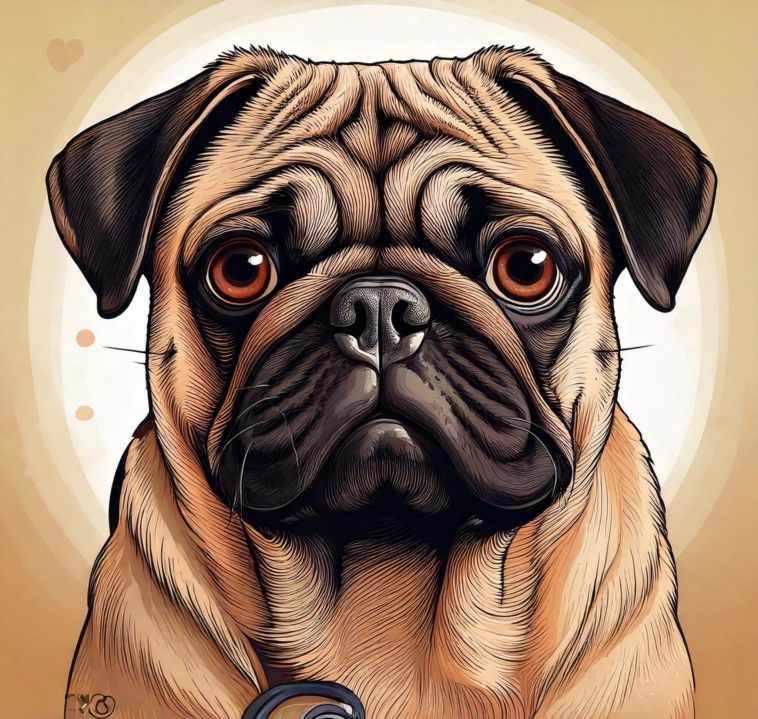Pug Life: The Hilarious, Snort-Filled Truth About Their Health Issues
Pugs are living cartoons—small and round, but full of more personality than legally should be permissible in a dog weighing less than 20 pounds. With their flat faces, curled tails, and perpetual air of mild confusion, it’s easy to lose sight of the fact that they arrive with a laundry list of health quirks. But with a pug comes accepting the chaos—and figuring out how to keep them living in their own strange way.
The Anatomy of a Pug Cute, Compact, and Slightly Problematic
- Wrinkled Faces: Their wrinkles aren’t there for show alone. They’re also ideal for catching dirt, moisture, and last night’s snack. Without regular cleaning, you’ll become familiar with “face funk” in no time.
- Short Muzzles: Due to their brachycephalic (a fancy way of saying “smushed face”) construction, breathing can become a bit of a challenge. Pugs are essentially wheezing, snoring bundles of affection.
- Curly Tails: The tighter the curl, the purer the pug, or so the myth has it. But really, it’s just an adorable corkscrew to look at while they make off with your sock.
- Sturdy Builds: Short and stout, but not at all dainty. Muscular, chunky, and surprisingly powerful when attempting to get lost from bath time.
- The Great Snort: Respiratory Drama Pugs are the poster pups for respiratory distress. Their short noses and flattened skulls cause each breath to sound like a clogged vacuum.
- Brachycephalic Airway Syndrome: Snoring, honking, and Darth Vader impressions are the norm. It’s humorous until they heat up or struggle with exercise.
- Stenotic Nares: Their nostrils are so small, they don’t really exist. Try breathing through a coffee straw—welcome to a pug’s daily life.
- Elongated Soft Palate: That excess tissue at the back of the throat flails about like a curtain in the breeze, causing breathing to sound dramatic and suspiciously like choking.
Those Big Googly Eyes: Adorable and Accident-Prone
Pugs eyes literally pop out of their heads actually in the worst cases.
- Corneal Ulcers: Their eyes are big fat targets. Simply brushing against a plant can result in a painful scratch.
- Proptosis: Sounds over-the-top because it is their eyes bulge out after trauma. Yes, actually.
- Entropion: Their eyelids roll inward from time to time and result in every blink being a scratch to the eyeball. Ouch.
- Dry Eye: Pugs may have difficulty making adequate tears, ironic for a breed so proficient at making people cry from laughing.
- PRA (Progressive Retinal Atrophy): An inherited disease that gradually causes loss of vision serious business that necessitates frequent vet visits
Skin Folds and Funk: The High-Maintenance Wrinkle Routine
With all that excess skin, Pugs are like the Shar Pei’s more humorous cousin—and just as clingy when it comes to skin care.
- Pyoderma: Bacterial infections are partying in dirty skin folds.
- Demodectic Mange: Mite-caused, resulting in bald spots and that “what did you do to your fur?” expression.
- Allergic Reactions: Food, pollen or fleas Pugs are scratchy little drama queens.
- Intertrigo: Fancy term for “my folds are infected again.”
- Seborrhea: Greasy flaky skin that has them resembling they lost a battle with a bottle of cooking oil.
Joint and Bone Shenanigans
Pugs weren’t precisely designed for sports. Or stairs. Or jumping off the couch.
- Hip Dysplasia: The joints don’t fit quite right, which can hurt to walk.
- Legg-Calvé-Perthes Disease: It’s in the hip bone and sounds like a French dessert rather than an illness.
- Patellar Luxation: The kneecap goes on unauthorized vacations to places it shouldn’t.
- Hemivertebrae: Twisted little vertebrae lead to back pain, and occasionally worse.
Pug + Food = Obesity
If you’ve ever watched a pug inhale an entire pizza crust and beg for dessert, you won’t be shocked that they gain weight more quickly than a couch potato during winter.
Why it Happens:
- Overfeeding: They’re tiny, but their appetite is gold medal material.
- Low Activity: Pugs aren’t exactly gym rats.
- Genetics: Some just carry fat like they’re getting ready for hibernation.
How to Fix It:
- Feed wisely: Quality food, measured portions, and fewer guilt-induced snacks.
- Urge gentle exercise: A quick walk, a toy runaround, or slipper-wrestling. Keep an eye on their weight like it’s your job because it kind of is.
Dental Drama
Small mouth + big teeth = dental chaos.
- Overcrowding: Too many teeth, not enough jaw. Brushing is tricky but necessary.
- Gum Disease: Plaque becomes tartar, tartar becomes trouble.
- Bad Breath: If the breath of your pug can melt wallpaper, it’s time for a trip to the vet.
- Tooth Decay: Food traps in all those crevices. A brushing a day keeps the vet away.
Pug Encephalitis: The Not-So-Funny Side
Also referred to as Necrotizing Meningoencephalitis, it is a rare, fatal, and pug-specific brain disease. Typically affects young pugs (6 months to 3 years).
- Symptoms: Seizures, stumbling, circling around as if they forgot where they parked.
- Diagnosis: MRIs, spinal taps, and enough tests to stock an entire sci-fi laboratory.
- Treatment: No cure, but meds can slow down the symptoms for a little while.
Early diagnosis is key. Think of it as catching the bad guy before the season finale.
Allergies: The Pug vs The World
Pugs are allergic to pretty much anything. Air. Food. Fleas. Existing at all.
- Common Triggers: Dust, pollen, processed food, flea bites.
- Symptoms: Itchy skin, sneezing, coughing, ear goo, and gastrointestinal drama.
- Treatments: Antihistamines, diets, and the fine art of keeping your home cleaner than a lab.

The Genetic Jackpot (Or Not)
Pugs have a default package of genetic problems that they bring along:
Brachycephalic Airway Syndrome
- Hip Dysplasia
- Pug Dog Encephalitis
- Patellar Dislocation
- Skin disease
And then add in cataracts, corneal conditions, and retinal problems later in life. It’s almost like a medical bingo card in waiting.
How to Upgrade Your Pug’s Lifestyle
- Nutrition: Good food with lean protein, measured portions, and the occasional indulgence (not a piece of your pizza).
- Exercise: Brief walks, indoor playtime, and brain games. No doggy CrossFit.
- Vet Visits: Puppies = every few weeks. Adults = once a year. Your vet is your pug’s life coach.
- Grooming: Brush once a week, wipe wrinkles often, inspect their eyes and ears, and bathe monthly (or after a wild mud party party).
- Dental Care: Brush those teeth like you’re cleaning grime off a valuable family heirloom.
In Conclusion: Pugs Are Wonderful Little Hot Messes
Having a pug is like having a wheezing, slightly disapproving toddler with a coat of fur. They have more health issues than the run-of-the-mill mutt, it’s true, but with love, attention, and a dash of humor, they’ll live snorty, snuggly, joyful lives.
Pug Parent Pro Tips:
Observe their breathing. Snorts are adorable—until they aren’t.
- Feed them intelligently. Don’t be guilt-tripped into a third breakfast.
- Clean their folds. The stench is no joke.
- Guard their eyes. Those cartoon eyes are delicate.
- Brush their teeth. Your nose will appreciate it.
- Visit the vet regularly. Better safe than surprise-surgery.
Because in the end, your pug might be high-maintenance—but they’re 100% worth it.
Let me know if you’d like this turned into a blog post or downloadable guide!




